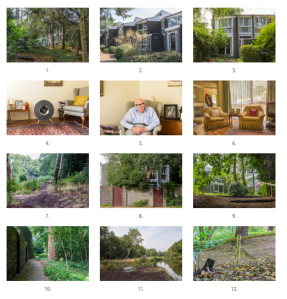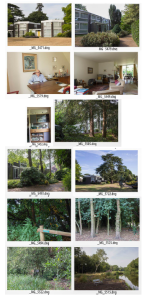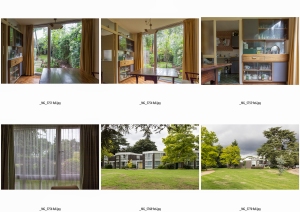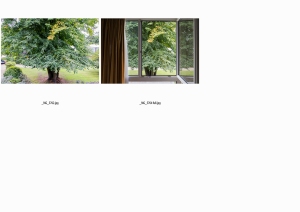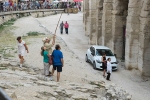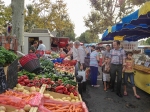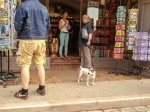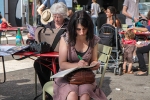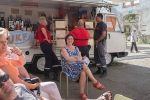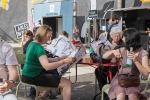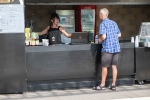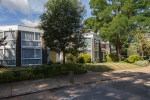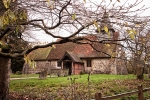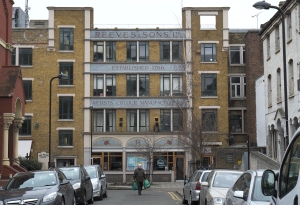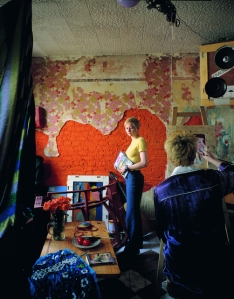A Design for Living
1: The Brief
I have my first commission. My ‘client’ is a Lifestyle Magazine called Designs for Living. The Magazine editor is interested in the way that housing developments designed in the 1960s have survived (or not) over time. The whole series will cover post-war housing developments from brutalist/high rise to neo-Georgian and all in between. I have been asked to :-
- Photograph and research ‘Templemere’ a private housing estate designed by the architect Eric Lyons and built by Span Developments in 1965 in Surrey. It was considered avant garde at the time and has just celebrated its 50th Anniversary.
- Visit at a time when the celebrations have ceased and the estate is functioning on an everyday basis.
- Provide photographs of the exterior and interior of one of more of the houses and the grounds of the estate.
- Interview and photograph one of the original residents and gain their view on how the original design has met its purpose.
- Obtain the views of other residents who moved in more recently.
- Provide contact sheets of at least 50 jpegs processed from RAW and suggest the twelve that I consider best reflect the brief and show how far the development has provided A Design for Living.
2: Planning
- Do background reading/research before the first visit to gain a sense of the intended ethos of Templemere.
- Check whether there were any original plans, older photographs or previous magazine articles about the Templemere and Span.
- Check whether Templemere has its own website as this provides another view on how the residents perceive the development.
- Contact one of the residents who is/has been very active in the Residents Society and arrange an initial visit to gain a sense of the environment.
- Ask for an introduction to a resident who has lived there since the houses were new; arrange an interview and gain permission to photograph the house interior.
- Interview any other resident available and ascertain their views on the estate.
- Photograph the interior of a house that has been updated as this might reflect any improvements considered necessary on the original building design.
- Photograph the grounds of Templemere.
- Ensure that I visit more than once so that I can photograph at different times of day.
3: Background Information
I did considerable reading around Eric Lyons, Span and Templemere and a fuller PDF summary of my notes can be accessed from the reference list . Eric Lyons was a visionary architect and a disciple of Walter Gropius, founder of the Bauhaus in Weimar, Germany in 1919, who came to England in 1934 .
Eric Lyons eventually joined forces as architect with Span Developments, created by Geoffrey Townsend. Their concept was to place people in communities with landscaped parkland that provided open spaces for community living. It was also intended that residents should take an active interest in the management of the estates through Residents Societies, “to make sure that the principles driving the project were propagated, and that distracting personalisations of shared space were prevented”. Amongst other developments Lyons, with Span, created and began building a village, New Ash Green, Kent that was subsequently sold and completed by Bovis when Span ran into financial difficulties. There certainly wasn’t unanimous approval of the new styles of modern building in the 1960s, with their large picture windows

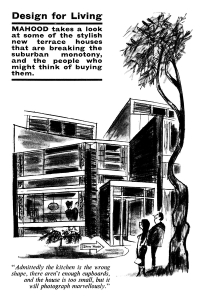
Reproduced with permission of Punch Limited., www.punch.co.uk
The house style is reminiscent of the ones created at Templemere and this cartoon appeared in a series by Ken Mahmoud in 1963 in Punch Magazine
4: Templemere
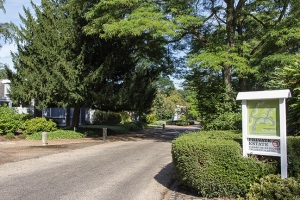
Templemere has its own website here that provides a wealth of information. The new estate was built within an C18th landscape that had been created by the Duke of Newcastle. It included a small wood and access to Broadwater Lake – also created by the Duke to mimic a river.
Previous Span developments had utilized courtyard gardens but it was realised that this would not work here as the houses had to match the C18th landscape. A new house type, L1, was created with an octagonal shape and linked/attached houses were staggered in outward facing groups with a central green area. 65 houses were built in 1963 and the estate won a Civic Trust award in 1964.
Eric Lyons gave a lecture to RIBA in 1968 where he explained that:-
It was not until we moved on to a beautiful site at Weybridge that we started having enough confidence to move away from the kind of external spaces we have been creating. Because of the enormous scale of some splendid cedar trees on the site I attempted to approach the problems of spatial organisation quite differently, to try and create less defined space. The space flows on like a water course and loses itself in all directions bubbling around the trees and clusters, going down into the wood and disappearing:
5: Meeting some of the Residents
I visited Templemere five times. I was concerned that this spread over in the school holidays and was worried that I may encounter problems if children were out playing, in terms of objections to photography etc. However this problem did not arise fortunately.
Two of the residents, Bill and Benda Boyd, spent some time with me on my initial visit, walking me round the estate and pointing out features of the grounds and house exteriors. They drew my attention to the many old trees with a feature point being a 400 year old Cedar tree.
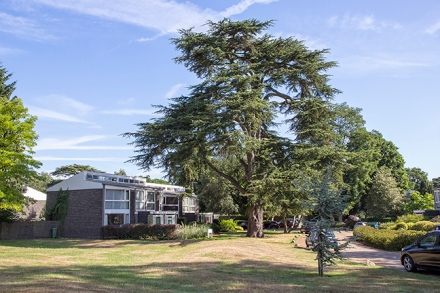
The wooded area by Broadwater Lake had been let go over the years but, 4/5 years ago, some of the younger residents got together and, with assistance from a specialist contractor, opened up the views. A special fund being created to pay for the work. They explained how the Residents Society operates. The management fee includes landscape maintenance of communal areas and painting of house exteriors on a rotational basis and the Residents Society organise several annual events as can be seen from their newsletter when the grassed community area in the centre becomes alive when residents gather. In the recent Queen’s Jubilee celebrations a walkway was built down to the woods by some of the men and opened with a ribbon. I was shown their names carved at the back of the post.
A few residents have made changes to exteriors, such as painting doors a different colour and the occasional installation of conservatories has created some controversy but, overall, I gained an impression of a very active Residents Society that is committed to maintaining a strong community spirit and upholding the original ethos of the development. I’m writing this advisedly because there will always people who want to make their own mark so there’s likely to be a continual process of discussion, negotiation and majority consensus. An Application is going to be made to have the estate deemed a conservation area and this should further protect the environment of the estate
I was told that the interiors of some houses have changed over the years apart from re-decorating. Some ground floors have become open plan; central heating has often been installed to replace the original more electrical underfloor heating and room has sometimes been found for a downstairs toilet. The houses seem to lend themselves well to this kind of adaptation and change.
Bill and Brenda enjoy living in Templemere. Bill likes their house for the large windows and light and Brenda likes the community feel – like a small village. She told me that 170 people came to the 50th Anniversary celebration earlier this year, including 30 former residents, which shows the hold that Templemere has over people.
b). Geoffrey Kemp
Bill and Brenda introduced me to Geoffrey and I had two visits with him. It was a real pleasure to talk with him, not to mention being introduced to a new delicacy – clotted cream and tawny orange marmalade on toast which was his late breakfast. He is very proud of his house and happy for me to have a look round and take photographs. He and his wife moved into Templemere as a newly married couple. He has been widowed for several years now but, at the age of 85, wants to stay where he is for as long as possible. Geoffrey considers this estate to be one of only a few examples of 1960s domestic architecture that’s any good. – “I think he’s [Eric Lyons] the greatest domestic architect since the war”.
He said:
I like the house for its tremendous sense of space, plus the grounds, lakes and woods and I have lots of friends here who are very supportive and keep an eye on me.
At his age one snag is the lack of a downstairs loo, but he likes the original concept so much that nothing has been changed and he still uses the original underfloor heating. It’s rather expensive – he sometimes uses the convection from a 1964 floor heater – but he likes it. His house also retains much of the original furniture, including the original two-way unit constructed between the kitchen and dining area “which obviates the need for a sideboard” (from original specification sheet).
There was also a possibility to talk with another newer resident who has modernized and converted his downstairs area to fully open plan but the timing was tight so this did not happen. Still, the possibility is there if I return to do more photography at some point.
A fuller account of my talks with residents can be accessed in the reference list.
The Photographs
85 of the original RAW images were converted to jpegs. From these I did an initial selection of 62 which I reduced to 34.
-

-
Contact Sheet 1 of 34 selection
-
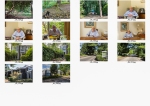
-
Contact Sheet 2 of 34 selection
These fell into four approximate sets, Geoffrey’s house; residents; the houses/estate; the woodland. I shared these (at 6×4 size) with the OCA Thames Valley group and it was really interesting to see how they started to put them together. Another advantage of doing this was that I could see from 6×4 prints images that would require some colour adjustment. My tutor will have access via Dropbox to digital contact sheets of all RAW files and the initial selection of 62 and I will send him printed contact sheets of the selection of 34 and A4 prints of my final 12.
I found it hard to pare it all down to 12. I wanted to avoid the look of an estate agent’s brochure and to bring Templemere to life somehow. I was drawn to the greenness of the woodland but then everything would probably have been too similar. Some people might say that one piece of woodland is the same as another but there was a difference for me. I experienced the woodland at Templemere as being a deeper green than my local Common – smaller and more intimate. Looking at my images I was reminded of Jem Southam’s work – see here and here The wildness contrasted with the more careful organisation of the houses within their immediate environment, although the houses themselves were also shrouded in the landscape as they flowed along together in their groups – just as Eric Lyons described in his lecture in 1968.
I could have chosen just to concentrate on Geoffrey but then I wouldn’t be showing the environment he loves and has lived in for so many years. He can no longer walk down into the woodland but I can show it to him. There were so many different edits I could do. I also started to wonder about sizes. For my tutor I’m preparing A4 prints with a border for handling. If I were to do it a different way – say for a small book then should the woodland be, say, full bleed so that the woodland flows off the page? Would it be better to have smaller images of Geoffrey and the interior of his house to show the scale of size compared with the buildings? It was certainly good to be aware of all those different possibilities but then I had to make a choice.
What came together for me was how the original concept has worked for 50 years and, in this particular instance fulfilled the vision of Eric Lyons and Span who aimed to create a particular kind of environment. Not a garden town, village or suburb but much smaller. Facilities such as shops etc might not be included but they lie close by. Residents live close to their neighbours (indeed are linked with them in groups) However, they live in a house that, although not large in space, is filled with light. They have a small garden to enjoy with privacy, yet are able to breathe and enjoy the environment around them as they step outside their front door. This small, self-organised community has the ability to support and offer friendship to its members as they grow older. Children can experience the magic of the woods relatively safely. I’m aware that all this might seem too fulsome but it works at Templemere because the residents, on the whole, are committed to such a concept.
I’ve been reading Yi-Fu Tuan’s book Space and Place: The Perspective of Experience (1977) as I’ve been pondering about sense of place for some time – see here . There were two sentences that struck me as I thought about Templemere
Compared to space, place is a calm center of established values (p. 54)
When space feels thoroughly familiar to us it has become place (p. 73)
And, with this in mind, these are the 12 I have chosen.
-

-
1.
-

-
2.
-
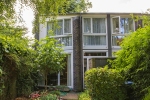
-
3.
-
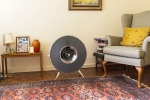
-
4.
-
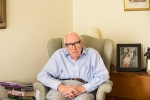
-
5.
-

-
6.
-
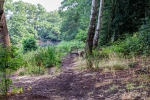
-
7.
-

-
8.
-
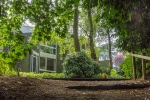
-
9.
-
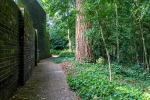
-
10.
-
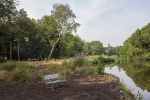
-
11.
-
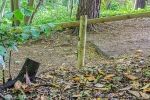
-
12.
Summary
The plan worked except for photographing the ultra-modernized interior of one of the houses, although that possibility is still available for me. The variation in sunlight on different days meant sometimes the sky was blue and sometimes white. Is it best to have uniform skies or not?
I enjoyed the researching and tried very hard not to research too much at the expense of taking photographs. My research notes will be in my paper log, together with copies of the emails with Punch magazine and the signed permission note from Geoffrey. It was good to meet and talk with the Boyds and with Geoffrey Kemp. If I was going to do it all again then I would have experimented with video and/or audio work, but will come as I plan to learn this during my next Module.
I’m looking forward to my tutor’s feedback – guessing that he might do a re-edit again. I wish I could be sitting there whilst he’s doing it so he could talk to me about it. That’s one of the aspects that I’ve gained so much from with the OCA Thames Valley Group and it would be good to do it with my own tutor.
3rd September 2013
References
Books
Barrett, C (2005) Spanning the Years in Grand Designs Magazine, March 2005.
Evans, P (2012) The 1960s Home, Shire Publications Ltd, Oxford
Harbison, R (2006) Exhibition, Architects Journal 30/11/2006
Simms, B (Ed) (2006) Eric Lyons & Span
Strike, J (2012)The Spirit of Span Housing, Strike Print, (Kindle ed)
Yi-Fu Tuan, (1977) Space and Place : The Perspective of Experience, University of Minnesota Press, Minneapolis.
Fuller PDV versions of Research notes
Summary background of influences on Eric Lyons and Span Developments and Templemere
Talking with some of the Templemere residents v1
Websites
http://www.amazon.co.uk/The-Spirit-Span-Housing-ebook/dp/B0090L9BJ6/ref=tmm_kin_title_0
http://www.architecture.com/Home.aspx
http://www.architectsjournal.co.uk
http://www.fonagvc.co.uk
http://en.wikipedia.org/wiki/Span_Developments
http://en.wikipedia.org/wiki/Walter_Gropius
http://punch.photoshelter.com/image/I0000LdxLj3EF7QI
http://www.ribabookshops.com/item/eric-lyons-and-span/58648/
http://www.ribapix.com/index.php?a=wordsearch&s=gallery&w=Templemere&go.x=0&go.y=0&go=Go
http://www.seesawmagazine.com/southam_pages/southam_interview.html
http://www.span-kent.co.uk/about_span.html
http://www.templemere.co.uk
http://www.thenbs.com/topics/designspecification/videos/eric_lyons_and_span.asp
http://www.vam.ac.uk/content/articles/l/landscape-photography-jem-southam/
http://www.weymede.co.uk/index.htm

















